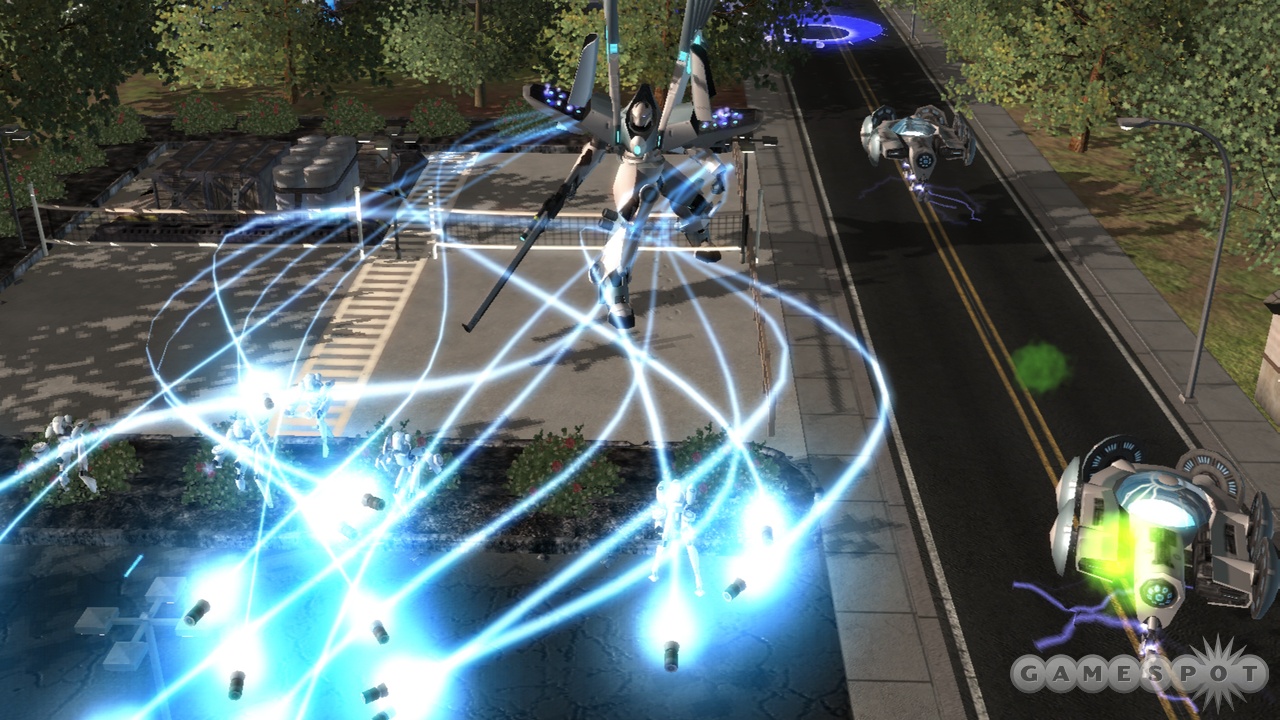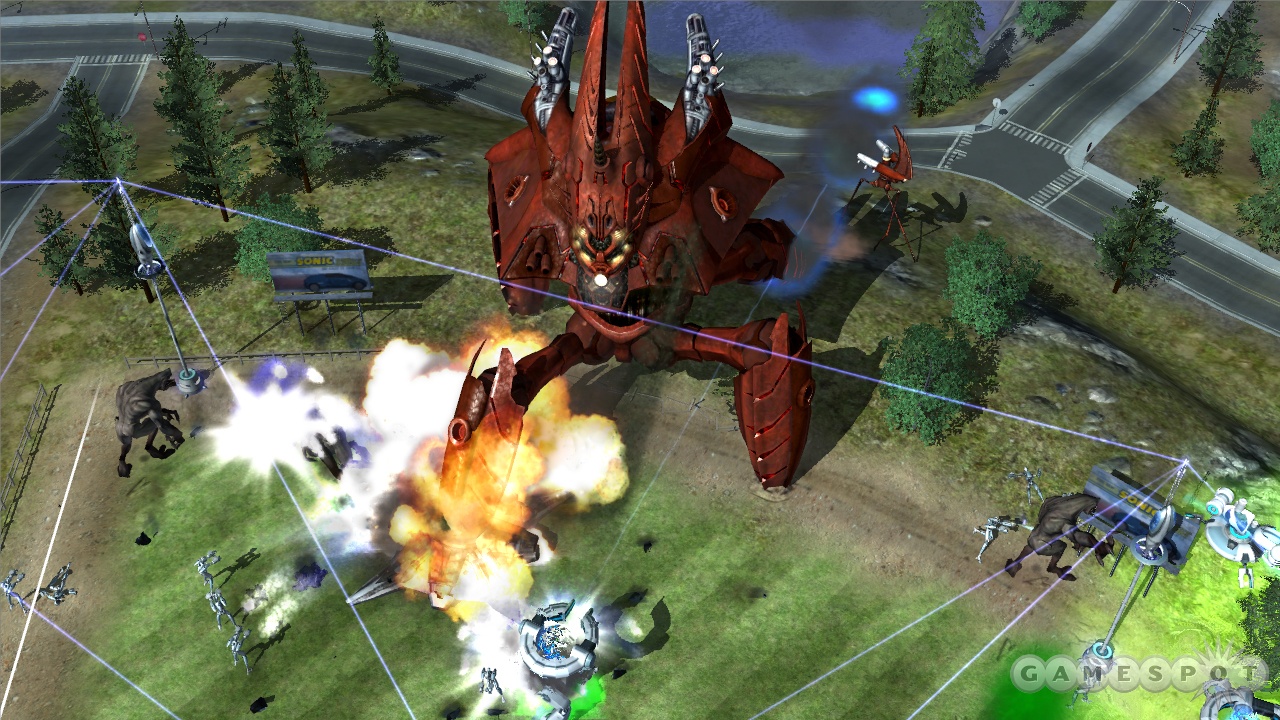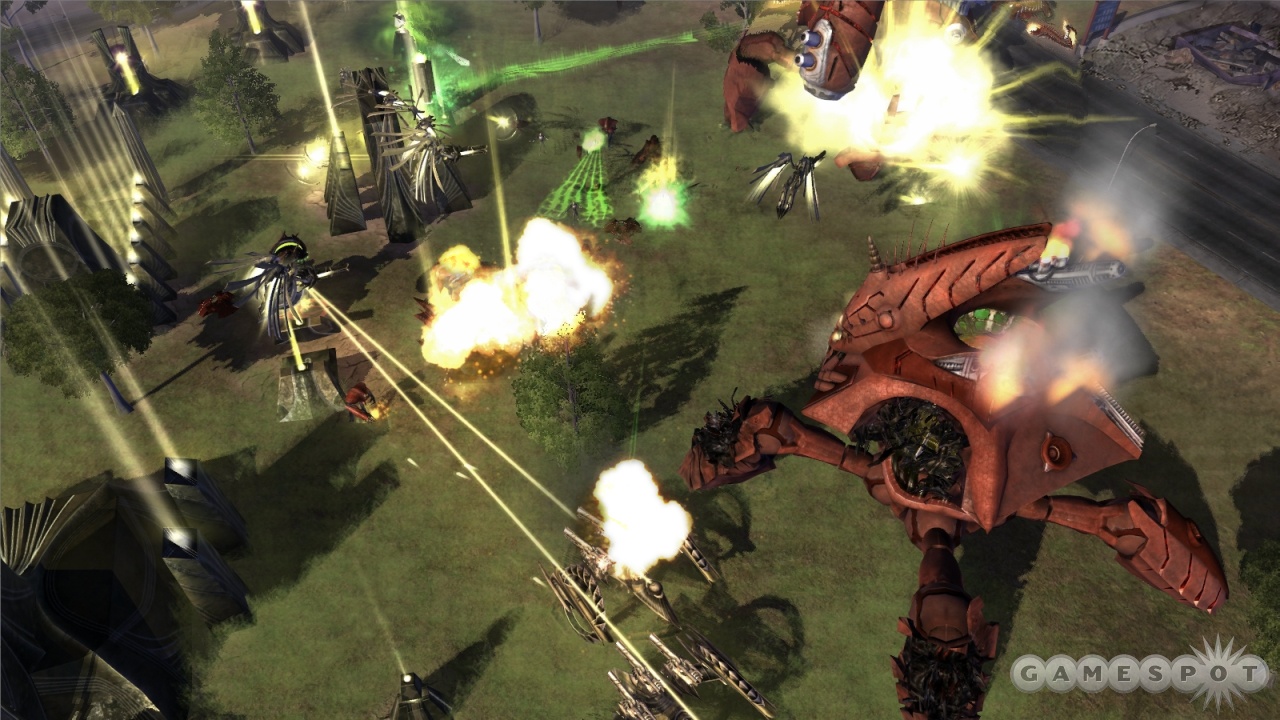Universe at War: Earth Assault Hands-On - Multiplayer With Three Alien Nations
The universe may be at war, but Earth is the battlefield. We get our hands on this upcoming sci-fi real-time strategy game.
We recently had a chance to try out some multiplayer sessions with Sega's upcoming real-time strategy game, Universe at War: Earth Assault. If the name sounds familiar, it's probably because this is the newest game from Petroglyph, creator of last year's smash hit Star Wars: Empire at War. But Universe at War isn't another Star Wars game. Instead, it's based in an entirely new game universe, one where the Earth is the battlefield for three galactic superpowers. And where are the humans, you might ask? Well, let's just say that mankind has seen better years. Most of the planet's population will be wiped out in the first few days of the invasion.
Unlike many RTS games, where each faction has very similar units and buildings, Universe at War seems to use a more Starcraft-like design ethos, in that each of the three races is completely different than the others, and each seems to require different tactics and strategies to win. It makes for an interesting multiplayer environment, to say the least.

Here's a quick rundown on how each of the three races shaped up in our multiplayer testing:
The Hierarchy
The Hierarchy are the 800-pound gorillas of the Universe at War mythology. These guys rule most of the galaxy, thanks to their huge "walker" war machines, which are essentially mobile factories that are capable of both delivering firepower and also constructing ground or air units. A single walker will fill most of your gameplay screen, and have the potential to be immensely powerful, but when you first create one, it's fairly vulnerable. To upgrade its powers, you need to build subsystems onto a number of hardpoints on its surfaces.
Each walker has six or seven hardpoints. Initially, you can build standard subsystems like armor plating or plasma cannons, but as you advance down one of the faction's research trees, you'll be able to construct more advanced weapons and structures, such as deployment pods that let walkers produce tougher units, or lasers that can cut across large swaths of the landscape. The smallest of these war machines is the science walker, which can't construct any units itself, but which can be upgraded with special subsystems, depending on your research. In our game, we managed to research upgraded lasers for the science walker, and after building three of them onto the war machine, the entire map's fog of war was lifted, letting us spy on everything our opponents were doing.
Currently, the walkers are probably a bit challenging to deal with in multiplayer. You can build a walker as soon as the game starts, and then start marching it towards your enemy's base. Because you can upgrade the hardpoints and have the walker construct units as it marches, it's possible to have a small army backed by a powerful walker hit your enemy's base minutes after the game begins, depending on the amount of resources you start the game with. Petroglyph is still tweaking their abilities, though, so we'd expect to see this "rush" strategy (the walkers are ponderously slow movers) be a bit more difficult to pull off in the final game. Also, you can build only a total of three walkers, so this strategy seems to force you to put all your eggs in one basket and hope your opponent doesn't hit you with a superweapon before you make your strike.
Masari
The Masari are a race of space-going astronauts that have come out of hibernation on the ocean floor to fight the Hierarchy after their appearance on Earth. They're perhaps the race that's easiest to get the hang of right off the bat, considering that they stick to mostly tried-and-true RTS gameplay. However, they don't collect resources in the same way the other factions do. Instead, they build massive batteries that collect energy from the atmosphere, albeit fairly slowly. When they have an economic base prepared, they build up their factories and begin pumping out units.

Masari units fall across the usual array of ground, vehicle, and aerial selections, and are apparently intended to be the best units in the game in terms of their power-to-cost ratio, which is good, because you'll need to build a number of batteries in order to collect enough resources to build up an army. Luckily for the Masari, the priests that construct their buildings are able to channel their powers into a specific structure. The priests are unable to move or construct any additional structures while channeling, but the buildings that they latch onto gain a number of bonuses: unit factories build more quickly, batteries suck in more energy, defensive turrets extend their range and firepower, and research structures research their tech faster. It's an interesting mechanic that forces the player to strike a balance between building a bunch of priests to supercharge their buildings, and spending those funds on more combat units or actual structures. At the very least, it should result in some interesting variety in opening strategies.
Lastly, if you play the Masari, you can flip at any time between the "light" and "dark" energies that power their civilization. Switching from light to dark, for instance, will shut down the streams of energy that float above the top of the structures, and most of the units will see a palette shift to indicate their wielding of dark energy. Each structure and unit has a slightly different function, depending on the energy mode that they're in, with the biggest change being that every unit in the army will gain an energy shield while they're in dark mode. Each change has a counterbalance, though. The angelic flying units that the Masari construct are grounded while dark mode is active, for instance.
War of the Worlds
The Novus
Lastly, the Novus are a race of cybernetic beings, survivors of a Hierarchy death-sweep that destroyed their organic creators in past millennia. Given the Novus' robotic and cybernetic origins, it's not too surprising that the entire race has a sleek and metallic look to it. They're intended to be the stealthiest race of the bunch, quick hitters that can move around mostly undetected and strike without warning. Although they don't pack as much of a punch as the Hierarchy or the Masari, they seem to be capable of moving more quickly, letting them perform hit-and-run maneuvers more capably than the other races.

The Novus are aided in their hit-and-run maneuvers by the presence of their "network." This is a series of bright lasers that connects to all of their buildings. If you attempt to move a Novus unit from one side of your base to another, it will move over to the nearest structure that's connected to the network, transform itself into energy, and zip through the laser beams until it reaches the building closest to its destination and continue on foot from there. This greatly decreases travel time, and has obvious combat implications, but you need to be careful because you have to construct a continuous chain of network nodes in order to transport yourself from place to place. You can either build full structures, or rely upon weaker (but cheaper) freestanding nodes to stretch your supply lines. We didn't get to explore the tech trees of the Novus to their full extent, but we'd have to imagine that they also have some way to plant a network node down away from their base to assist in their surprise assaults.
Tech Trees, Hero Units, and Achievements
Although the three races are already fairly unique, Petroglyph has gone the extra mile in making multiplayer a constantly unique experience by allowing each race to dabble in technological research. Each race has 12 separate technologies that can be researched, which are organized in three separate lines of four techs apiece. Fans of World of Warcraft might recognize this idea as being similar to the talent trees that each class in that game possesses; they allow the experience of playing (and fighting against) each race to be markedly different from game to game.
Although there are 12 separate techs to research, you can only research six of them in any given multiplayer match. If you wish to do so, you can start by fully researching one of the tech branches to get the powerful abilities at the end of it, or you can dabble in each branch. However, it's obvious that you want to reach the second level of a research branch as quickly as possible, because that will allow you to build a powerful hero unit. Each branch of tech will have a different hero unit available at the second level, so if you choose to, you can split up your six tech points and put two into each tree, allowing you to build three hero units, but costing you the opportunity to get the high-end research at the end of any one of the trees.
Beyond the hero units, the tech trees also reinforce certain aspects of the race and make them markedly different if you research different techs. If you play against Hierarchy players, they'll always be using walkers, but you won't know if they're focusing on radiation weaponry that will slowly kill your troops after you engage them, or if they're researching laser weaponry that will aid in battles against vehicles. The Masari tech trees will allow them to focus on either light or dark energies, thus making their units more powerful in their chosen field. Whatever the case, it's difficult to be too sure of what kind of research your opponent is using until you actually engage him or her, which usually makes for a tense first encounter.
Given that Universe at War is going to be coming to both the Xbox 360 and to the PC, each version will have achievements to earn. Although we didn't get to see these ourselves, we're told that earning achievements will also unlock certain medals that can be used in multiplayer; selecting medals before a game starts will let you gain certain advantages for your faction throughout the entire game.
Universe at War is currently shaping up to be a gorgeous and engaging RTS. It's going to ship this fall for the PC, and early next year for the 360, so stay tuned for more information.
Got a news tip or want to contact us directly? Email news@gamespot.com

Join the conversation